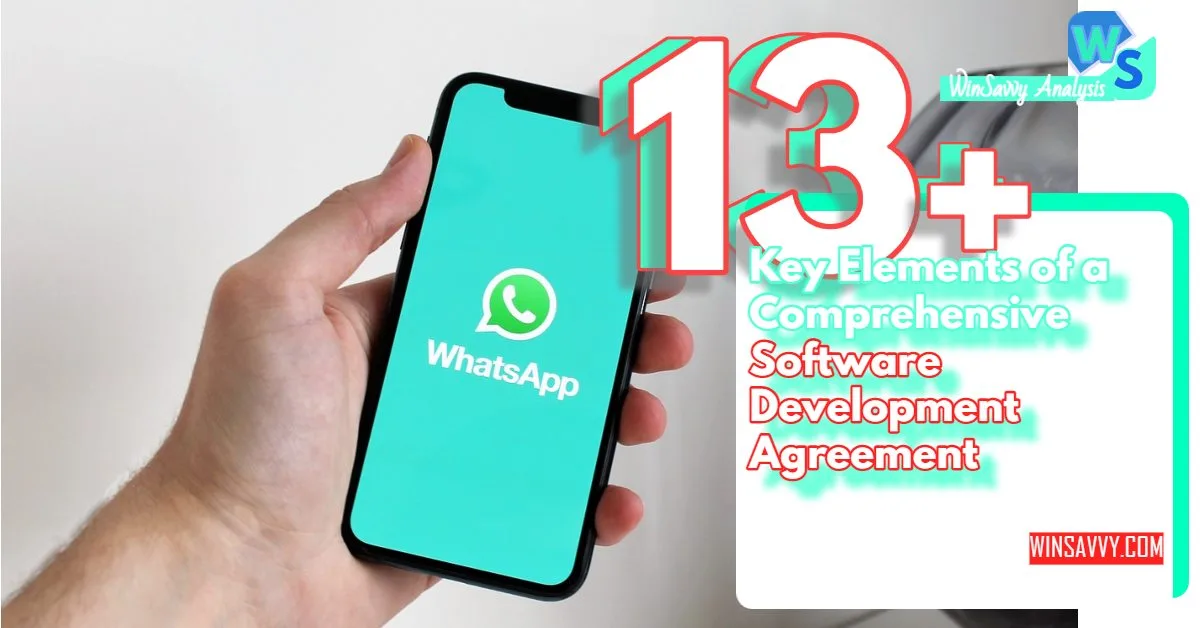In today’s fast-paced digital world, software development has become a crucial aspect of business operations. A well-drafted software development agreement can ensure that both the developer and the client are on the same page, mitigating potential conflicts and fostering a successful working relationship.
Under Indian law, software development agreements are primarily governed by the Information Technology Act, 2000 (IT Act) and the Indian Contract Act, 1872.
This article, will delve into the key elements of a comprehensive software development agreement, highlighting the relevant laws, sections, and regulations that you should consider when hiring any developer to create any software for you or your business.
Note – This article is based on Indian law.
#1. Parties Involved

A. Identification of the developer and client
A software development agreement should clearly identify both the developer and the client, specifying their respective legal names, addresses, and contact information. In India, parties to a contract can be individuals, sole proprietorships, one-person companies, or other types of legal entities. Choosing the right type of legal entity is crucial, as it impacts tax liabilities, compliance requirements, and legal exposure .
Related Read: Should You go for a Sole-Propreitorship or a One-Person Company
B. Roles and responsibilities of each party
Clearly outlining the roles and responsibilities of the developer and the client is essential for a smooth project execution. This includes specifying each party’s obligations concerning project management, communication, and the provision of necessary resources or information.
C. Legal capacity to enter into a contract under Indian law
Under the Indian Contract Act, 1872, both parties must have the legal capacity to enter into a contract. This means they must be of legal age (18 years or older), of sound mind, and not disqualified from contracting by any law.
#2. Scope of Work
A. Detailed description of the project
To avoid ambiguity and potential disputes, the agreement should provide a detailed description of the software project, including its purpose, objectives, and specific requirements or constraints. This should encompass a list of required features, functionality, and technical specifications. Furthermore, the agreement should incorporate any applicable industry standards, guidelines, or best practices.
B. Deliverables and milestones
A comprehensive agreement should enumerate the expected deliverables and milestones, such as prototypes, alpha and beta versions, and the final product. These should be clearly defined and measurable, facilitating objective acceptance testing and progress evaluation.
C. Acceptance testing and criteria
Establishing acceptance testing procedures and criteria in the agreement ensures that the delivered software meets the client’s requirements. This process typically includes a review, testing, and approval by the client before the software is considered accepted and payment is released.
This section of the agreement should also outline the steps to be taken if the software fails to meet the acceptance criteria, such as bug fixing, retesting, or even termination of the contract in extreme cases.
#3. Project Timeline and Schedule
A. Project start and end dates
Establishing the project’s start and end dates in the agreement ensures that both parties are aware of the expected timeline for completion. This also helps set expectations for resource allocation and project management.
B. Milestones and deadlines
The agreement should outline the project’s milestones and associated deadlines, providing a clear roadmap for progress monitoring and accountability. These milestones should be realistic and achievable, taking into account the project’s complexity and potential challenges.
C. Process for managing changes to the project scope or timeline
A robust software development agreement should include a change management process, outlining how modifications to the project scope, timeline, or budget will be addressed. This typically involves a written request for changes, evaluation, and approval or rejection by both parties.
A well-defined change management process can help minimize project delays and cost overruns, as it ensures that any adjustments are handled in a structured and transparent manner.
#4. Payment Terms
A. Fees and payment structure
The agreement should detail the fees and payment structure for the software development project, such as fixed-price, time-and-out-of-pocket-expenses, or milestone-based payments. Clearly specifying the payment terms can help avoid disputes related to invoicing and compensation.
B. Payment milestones – Having this clause in a software development agreement helps avoid future disputes and confusion.
Payment milestones should be established in the agreement, linking them to the completion of specific deliverables or milestones. This approach helps ensure that the developer is fairly compensated for their work while incentivizing timely progress.
C. Invoicing and payment methods
The agreement should outline the invoicing and payment methods, specifying any required documentation, payment schedules, and acceptable modes of payment. It should also address currency exchange rates if the parties are based in different countries.
D. Penalties for late payments or non-performance
The agreement may include penalties for late payments or non-performance, such as interest charges or termination rights. This can help encourage compliance with payment terms and project deadlines.
#5. Intellectual Property Rights – This is a Risk-Aversion Clause that should be present in a Software Development Agreement
A. Ownership of pre-existing IP
The agreement should clarify the ownership of any pre-existing intellectual property (IP) used in the project, such as software libraries, frameworks, or design assets. Typically, pre-existing IP remains the property of the party that originally owned or licensed it.
B. Assignment or licensing of IP created during the project
The agreement should address the ownership or licensing of IP created during the project. This may involve assigning the IP rights to the client, granting the client a license to use the IP, or retaining the IP rights with the developer.
C. Moral rights and attribution
In India, authors of copyrighted works, including software, have moral rights, which include the right to be attributed as the author and the right to object to derogatory treatment of their work. The agreement should address how moral rights will be handled in the context of the software development project.
D. Infringement warranties and indemnification
The developer should provide warranties that the software does not infringe on any third-party IP rights, such as patents, copyrights, or trademarks. The agreement should also include indemnification clauses, which protect the client in case of any infringement claims made by third parties.
#6. Confidentiality and Non-Disclosure
A. Definition of confidential information
The agreement should define what constitutes confidential information, which typically includes trade secrets, business plans, customer data, and other sensitive information shared between the parties during the project.
B. Obligations to protect confidential information
Both parties should agree to protect each other’s confidential information by not disclosing it to third parties or using it for unauthorized purposes. This can be achieved through the use of confidentiality or non-disclosure clauses in the agreement.
C. Exceptions to confidentiality
The agreement should outline any exceptions to the confidentiality obligations, such as information that is already public or is required to be disclosed by law.
D. Duration of confidentiality obligations
The agreement should specify the duration of the confidentiality obligations, which often extends beyond the termination or completion of the project.
#7. Warranties and Representations – The Most Essential Component for Risk Aversion in a Software Development Agreement
A. Standard of care and performance
The developer should provide warranties regarding the standard of care and performance they will adhere to while working on the project. This may include complying with industry best practices and applicable laws and regulations.
B. Conformity with specifications
The developer should warrant that the software will conform to the agreed-upon specifications, requirements, and functionality outlined in the agreement.
the software will conform to the agreed-upon specifications, requirements, and functionality outlined in the agreement.
C. Freedom from defects
The developer should warrant that the software will be free from defects, both in terms of functionality and security. This warranty may cover a specific period post-delivery, during which the developer is responsible for fixing any identified defects.
D. Compliance with applicable laws and regulations
The agreement should include warranties that both parties will comply with all applicable laws and regulations, such as data protection and privacy laws, intellectual property laws, and labour laws In case, you are creating a software that has specific regulatory applications on it, such as, a platform intermediary, you need to ensure your business follows those specific laws (for example, platform business laws in that case).
#8. Limitation of Liability and Indemnification
A. Limitation of liability
The agreement should establish limitations on each party’s liability, specifying the types of damages that can be claimed and any monetary caps on potential claims. This helps both parties manage their risk exposure.
B. Indemnification
Indemnification clauses protect both parties from losses or damages resulting from the other party’s breach of the agreement, negligence, or willful misconduct. The agreement should clearly define the scope of indemnification, the process for claiming indemnification, and any limitations or exclusions that apply.
#9. Termination and Dispute Resolution
A. Termination rights and conditions
The agreement should outline the termination rights of each party, specifying the conditions under which the contract can be terminated, such as breach of contract, insolvency, or failure to meet milestones or in case of merger or acquisition of a party. The reason behind this is that, when parties merge or when a party gets acquired, the contract gets assigned to another party.
That’s why, having the option to void the agreement (voidable clause) allows you to make appropriate considerations at that time.
B. Consequences of termination
The agreement should detail the consequences of termination, including the return or destruction of confidential information, the payment of any outstanding fees, and the transfer or licensing of intellectual property rights, as applicable.
C. Dispute resolution
The agreement should specify the dispute resolution mechanism to be used in case of conflicts between the parties, such as negotiation, mediation, arbitration, or litigation. Specifying the governing law and jurisdiction for resolving disputes is also essential (source: Why Contract Management is Important for Your Business: in 2023).
#10. Assignment and Subcontracting
A. Assignment of rights and obligations
The agreement should clarify whether the parties are allowed to assign their rights and obligations under the contract to third parties. If assignment is permitted, the agreement should specify the conditions and any required consent from the other party.
B. Subcontracting
The agreement should address whether the developer is allowed to subcontract any part of the software development project to third parties. If subcontracting is permitted, the developer should remain responsible for the performance and actions of the subcontractors, ensuring that the quality of the work is maintained, and adhering to the terms of the agreement.
#11. Non-Compete and Non-Solicitation Clauses
A. Non-compete clause
A non-compete clause restricts the developer from engaging in any competing business or working on similar projects for the client’s competitors during the term of the agreement and for a specified period after its termination. The agreement should define the scope, duration, and geographic limitations of the non-compete clause to ensure that it is enforceable under Indian law.
B. Non-solicitation clause
A non-solicitation clause prohibits the developer from soliciting or hiring the client’s employees or customers during the term of the agreement and for a specified period after its termination. The agreement should outline the scope and duration of the non-solicitation clause to protect the client’s business interests.
#12. Data Protection and Privacy – A Software Development Agreement Must Have

Why do you need this in a software development agreement?
This helps you lower your liabilities and can help you transfer the responsibility to your developer. That way, you will enjoy a greater safety net and your developer will be required to put forward a higher degree of responsibility and commitment towards the development process.
A. Compliance with data protection laws
The agreement should address the parties’ obligations to comply with applicable data protection laws, such as the Information Technology (Reasonable Security Practices and Procedures and Sensitive Personal Data or Information) Rules, 2011, under the Information Technology Act, 2000.
This includes ensuring the confidentiality, integrity, and availability of personal data, as well as providing appropriate notice and obtaining consent from data subjects
B. Data processing and storage
The agreement should specify the parties’ responsibilities related to data processing and storage, including the location of data storage, the use of encryption, and any data retention or deletion requirements.
C. Data breach response
The agreement should outline the process for responding to data breaches, including notification obligations, investigation and remediation efforts, and cooperation between the parties to mitigate the impact of the breach.
#13. Escrow Arrangements
This clause is a nice-to-have in a software development agreement.
In some cases, parties may choose to establish a software escrow arrangement to protect the client’s access to the software source code in case the developer becomes unable or unwilling to provide support or maintenance.
The agreement should address the terms of the escrow arrangement, including the selection of an escrow agent, the conditions for releasing the source code, and the rights and obligations of the parties upon release.
#14. Miscellaneous Provisions
A. Governing law and jurisdiction
The agreement should clearly state the governing law and jurisdiction for interpreting and enforcing the contract. This is particularly important when the parties are based in different countries or states.
B. Notices
The agreement should specify the process for providing notices between the parties, including the mode of communication, addresses, and any required timeframes.
C. Entire agreement and amendment
The entire agreement clause confirms that the written contract represents the complete understanding between the parties and supersedes any prior negotiations or agreements. The agreement should also outline the process for amending the contract, which typically requires a written document signed by both parties.
D. Force majeure
A force majeure clause addresses unforeseeable events beyond the control of either party, such as natural disasters, wars, or pandemics, that may prevent one or both parties from fulfilling their contractual obligations. The clause should define the scope of force majeure events and the process for notifying the other party in case of such an event.
E. Relationship of the parties
The agreement should clarify that the parties are entering into a contractual relationship as independent contractors, and not as partners, joint venturers, or employer-employee.
Wrapping it up
In conclusion, a comprehensive software development agreement is crucial for mitigating risks and ensuring a successful project outcome.
By addressing the key elements discussed in this article, you can establish a solid legal foundation that supports your and the developer’s collaboration and protects your interests under Indian law.
Read Next:
- What’s the Digital Rupee and What is its impact on Indian Businesses?
- How to Draft a SaaS Agreement: Explained!
- How to create a Software Licensing Agreement: Our Framework!




















